A few weeks ago I tried something that has really sparked some interest! I was inspired by a video I watched. The video is embedded below. I encourage you to take the time to watch it in its entirety, but the part of it that inspired the study my students and I embarked on was at 6:43. The speaker had looked at a newspaper headline and identified which language each word in the headline came from. The headline was, “Trump, pushing immigration plan, meets with family of woman killed in 2007.” Out of the ten words (excluding Trump and 2007), he finds that 5 are Germanic and 5 are Romance words (from a romance language like French, Italian, or Spanish). Following that interesting find, he chooses a more casual sentence: “I had lunch with my friend, and we read some books.” This sentence leans more toward what we might think of as the casual writing of everyday activities. This time he found that almost all of the words were Germanic.
This look at our everyday writing got me thinking. What would my students find if we did this same kind of activity? In what ways would it help them understand their language better?
To begin with, I thought of and wrote the following sentence on the board:
“The three trees stood proud and tall like kings.”
I was curious to see their reaction to this activity. I did not look at the origins of each word ahead of time because I truly love being delighted or stumped along with my students. We often investigate and discover together in this way.
In order to keep things moving, I stayed at the computer at my desk and searched each word at our favorite etymological site, Etymonline. The students could see each entry on the Smartboard as I called it up. By doing it this way, I could model how to read the entry and find out the language of origin for each word. First I asked the students if they had any idea where the first word, <the>, came from. There were several guesses before I called up the entry for it and we found out together that it is from Old English. I asked one of the students to come to the board and write an O.E. beneath <the>. I also asked the volunteer to write the Old English spelling of the word (þe) beneath the O.E. With each new word, I asked someone new to come to the board to do the writing. Then I asked students where the word came from. After three guesses, I called up the entry for that word so we could all find out at once.
As we moved along through the sentence, the students seemed surprised that they weren’t finding words of Latin or Greek origin. There were even sighs of disappointment when once again we found a word from Old or Middle English. I, on the other hand, was quite fascinated. We had the opportunity to talk about the Old English letter thorn (þ) and then noticed it in þreo, the Old English spelling of <three>. There was a level of surprise that the Middle English spelling of <tall> and the Old English spelling of <and> were so similar to that of Modern English. We had some fun imagining the Old English spelling of <king> being contracted from cyning to <king> as was mentioned in the entry at Etymonline.
The fact that the students were expecting most of the words to be from Latin or Greek, got me thinking. I begin the year by investigating science words. It works well as a way to introduce the idea that words have structure, a history, and both morphological and etymological relatives. But by spending all that time looking at words that share Greek and Latin bases, my students formed a false impression of the language we use every day! It was time to collect some data and get a more accurate picture.
So I asked them. What do you suppose we’d find out if we each made up a sentence (like I did) and then went through and identified each word as to its language of origin? Most thought that things would even out and we’d have sentences that were mostly Latin or Greek. There was only one way to find out for sure, and these fifth grade students were willing to do their part! At the time, we were finishing up writing essays on the photosynthesis process and its importance in our world. So as students reached that final stage in which their final edits were approved, they moved on to this project.
They began by thinking of a sentence. They wrote it in their orthography notebook, and then reached for a Chromebook so they could access Etymonline. Once they were finished with that step, I had them print the sentence on white paper so I could put them on a lengthy bulletin board I have outside my room. As they were doing this, we decided to color code the languages of origins so that people pausing to look at our bulletin board might recognize quickly how many words are from each language.
This is not a complete listing of the languages we found, but it includes many of the languages we found. Here are a few examples of the student work.
The student who wrote the sentence presented the findings to the class. In order to save time, I would write the sentence on the board along with the language and original spelling below each word. Then I taped a piece of paper over the language of each word to conceal it. When the students entered the room, it was ready. The student presenting asked the class, “What language do you think ____ came from?” Then they removed the piece of paper that had been concealing the answer. It was fun this way and all the students were engaged.
As the first dozen were completed, we began to notice some things. We noticed how often we use the articles “a”, “an”, and “the” in sentences, and how similarly we spell those words now. We noticed other smaller size words such as prepositions, possessive determiners, linking verbs, and pronouns whose spelling was remarkably similar to our present day spelling. We recognized them as function words. We began finding a few more words from Old French and Latin, but the majority of the words we used were still from Old English. We saw the Old English letters ash (æ) and thorn (þ) pretty regularly. It was time to learn more about Old English letters that we sometimes see in IPA, but not in Modern English spelling. The narrator in the following video speaks pretty fast, but has a sense of humor that the students enjoyed.
We stopped every once in a while to reflect on the information we were hearing. In Old English, thorn (þ) and eth (ð) were used interchangeably to represent the voiced dental fricative /θ/. We wanted to know the difference between a voiced dental fricative and an unvoiced dental fricative. Stopping to feel the difference in our mouths helped us understand the difference between voiced and unvoiced, and it also caused us to pay attention to the position of the teeth and the tongue. That helped us better understand the use of the words dental and fricative! After watching that video, I made a list that we could refer to while we were sharing sentences at the board.
The more sentences we looked at together, and the more sentences that were completed individually, the more the students became familiar with the Old English words we were seeing over and over. They were feeling comfortable with Old English and even flipped that initial feeling of regret at finding many words of Old English origin to a feeling of pride at finding so many words of Old English origin. The students began asking questions about English. Was Old English older than Latin? Even though we had been over at the map and talked about the invasions that happened quite often in the history of England, it was clear that we were in need of a timeline that would help the students visualize the important reasons that English changed as the years rolled by.
Finding one I liked was not as easy as I thought it would be. Many that are available online are visually busy. I needed one that was straightforward and that my students would understand. My plan was to give additional information regarding certain events as we read through the timeline together. So with the help of the following 4 webpages, I put together my own idea of important events in the History of the English Language. In doing so I am keeping my audience in mind (my 10 year old students). This is not meant to be complete and likely would not suit everyone’s purpose. But it suits mine.
Professor S. Kemmer, Rice University
Richard Nordquist, ThoughtCo.
David Wilton, Wordorigins.org
Luke Mastin, The History of English
Before the students glued the two pages of the timeline together and labeled it, we read it together and paused in places to better understand certain events. I also had the students mark off the periods in which Old English, Middle English, Early Modern English, and Late Modern English were (are) spoken. The students were surprised to see that Modern English began in 1500. We wondered what the next period would be called. What would follow “Modern English”?
To mark the beginning of “Old English”, I shared a map showing where the Angles, Jutes, and Saxons came from and another one showing where they settled. The Angles and the Saxons became known as the Anglo-Saxons. Here is what Etymonline says in its entry for English:
English … “of or pertaining to the Angles,” from Engle (plural) “the Angles,” the name of one of the Germanic groups that overran the island 5c., supposedly so-called because Angul, the land they inhabited on the Jutland coast, was shaped like a fish hook.
So the land of the Angles became “Angle-land”. According to Etymonline, the Old English word for it was Englisc, and was used in reference to the whole Germanic people of Britain. We still have words related to the Angles such as Anglians and anglicize.
By User:Hel-hama – Vectorization of File:Britain peoples circa 600.png drawn by User:IMeowbotborder data from CIA, people locations from The Historical Atlas by William R. Shepherd, 1926 edition, with clarifications supplied by en:User:Everyking per references used in en:Penda of Mercia. Anglo-Saxon coastline from Hill, ‘An Atlas of Anglo-Saxon England’ (1981) (the grey areas marked ‘sea, swamp or alluvium’ show where little Anglo-Saxon settlement occurred, because (according to Hill) there was at different periods either large areas of mud, marshland or open sea)., CC BY-SA 3.0, https://commons.wikimedia.org/w/index.php?curid=4684278
Another event that I felt needed a map to illustrate what was happening in Britain was that of the Danelaw being established. As you can see, Britain was divided into Anglo-Saxon ruled areas and Danish or Norse ruled areas. A treaty between the King of Wessex, Alfred the Great, and the Danish ruler, Guthrum, promised a peaceful existence between the English and the Vikings.

By Hel-hama – Own work, CC BY-SA 3.0, https://commons.wikimedia.org/w/index.php?curid=19885072
Because 1066 is such an important date in the history of our language, I specifically looked for a video that would spotlight the significance of its events. As we were coming across words from French, we had talked a bit about the Battle of Hastings, but I could tell something was missing. The students weren’t understanding how French and English were existing side by side. This video does a nice job of explaining just how that worked. With this background, the students will be able to picture the two languages blending into one as the Norman nobility changed its perspective c.1300.
Curious about an idea that the Old English people had a word that named the animal and the Normans had a word that named the meat, two boys asked if they could investigate animal and meat words. They wondered if this “Old English/Norman French” connection was the case with all the animals/meats they could think of. One of the boys lives on a farm and had a particular interest in this collection. Here is what they found.
There were a few interesting discoveries as you might imagine. They were surprised that <steak> was from Old Norse, and that <rabbit> was from Middle Dutch. I wish you could have heard the bubbling-over fascination with which they shared these lists!
The timeline was not created to be part of an in-depth study, but rather to suggest some things to consider when we think about how our language developed and became what it is. In the coming months, I plan to ask which event my students would like to know more about so that we can revisit this timeline and better understand the people who brought about changes to the English language. Just as we try to help students develop a “math sense”, this kind of exploration has helped the students develop a “language sense.”
Moving on in our familiarity with Old English, I showed the students a book I purchased last year.
The first lesson can be found on Youtube. I like listening to the pronunciation of the Old English in the video version. My students did too. They could figure out what was being said because of the pronunciation and being able to see the words. The book has further lessons, and there is a site you can access to listen to those as well, but there is no video portion.
Again we had the chance to point out that in Old English the <h> was first and the <w> was second in the word hwā (who). To hear both letters pronounced will help students remember why they are both present in so many of our modern words, even though the <h> is now second and no longer pronounced. Another thing the students found interesting was the way a person’s age was phrased.
“ic eom golde! ic eom nigon and twentig gēar eald.”
I am Golde. I am nine and twenty years old.
The students also recognized:
wīf for wife,
mōdor or mother,
fæder for father,
sunu for son,
dohtor for daughter,
sweostor for sister,
brōðor for brother,
hund for dog
The first time we watched it, we paused to practice saying the Old English and sharing any reactions. The second time we watched it, we kept silent and individually followed along with the narration being presented. The next day when the students came into the room, I had written this on the board:
According to the book, the translation is, “Hello! Be you well!” or simply, “Hello! Be well!” As you can see, we are having fun embracing our Old English roots!
Seeing as we have Beowulf listed on our timeline, I found a video of a bit of it being read in Old English:
Then I found a short video of The Canterbury Tales being read in Middle English:
Then I found some Shakespeare being read in Early Modern English:
There is a beauty in each of these recitations. My intention here was to have the students listen to each reading without struggling to understand what was being said. I wanted them to appreciate the differences between poetry written in Old English, Middle English, and Early Modern English and yet enjoy and recognize the beauty in each.
Our Data
Two of my students volunteered to keep track of how many words were from each of the different languages. Each day they looked at newly submitted sentences and added to their count. They also tallied how often a single word (from Old English) was used. Here are the stats for our results:
Sentences submitted: 49
Total words: 354
At this point, we were expecting Old English to be the biggest category in a pie chart or bar graph, but this visual representation of our data made several students say, “Oh, wow!”
The “miscellaneous” category included words for which we couldn’t find a definitive origin, words from Greek, and words the student researcher wasn’t sure of. The category called “Romance Languages” includes words from Latin. Latin is not a Romance language itself. Romance languages were derived from Latin. Here is the same information in a bar graph:
Next we made a bar graph that shows the breakdown of the Germanic languages:
And here is a breakdown of the words from Latin and from the Romance languages derived from Latin:
One other thing that we collected data on was how frequently certain words were used.
Next we sorted these frequently used words by their part of speech.
Because we have been studying grammar, we were really not surprised that the articles “the” and “a” would be the most frequently found determiners. Determiners are found in most sentences. Prior to this study, we never really stopped to wonder what language they were from.
The subject pronoun “I” was the most frequently used pronoun.
I recognize that some words listed here can function as other parts of speech, but in the sentences used in our study, they were functioning as verbs. The students were not surprised that “like” and “is” are so commonly used.
Although we have talked about function and lexical or content words before, this was a perfect time to review them. So many of the words we used frequently in this study were function words! That in itself points to the difference between the two categories. Function words are those that point to a grammatical relationship between words in a sentence. They are more difficult to define when isolated because that is not how we use them. Function words are generally determiners, conjunctions, auxiliary and linking verbs, and prepositions. Lexical or content words are generally nouns, action verbs, adjectives, and some adverbs.
Wrapping it Up
So what have we learned? For one, we’ve proven to ourselves that Old English is indeed the bedrock of our language. In the sentences we thought of, 80% of the words we used were of Old English origin! After looking at six or so sentences, we began to realize that most of the words we use would be of Old English origin, but 80% is a bigger percentage than any of us were expecting.
We’ve also learned that even though many words in our language are Latinate, fifth grade students don’t use that many of them on a daily basis. Many will be found as the students begin to increase the amount of academic writing they do at the next levels of their education. When writing reports and essays, we tend to use a tone that is of higher register. When we do, words of Latin and Greek heritage naturally become part of our writing. This point goes back to the video at the beginning of this post in which the narrator noticed that a newspaper headline was composed of words of which 50% were Germanic and 50% were Romance. Writing for a newspaper calls for use of a higher register than writing a note to a friend would.
Along the way, the students had exposure to some of the events that shaped our language. Since so many of the words we found were from French, I felt it was especially important to give the students information about the Norman Invasion of 1066. The student’s interest has been piqued and they are looking forward to learning more! Learning about this particular event inspired the separate investigation by the boys who looked into words for animal names and words for the meat of those same animals. As these same students begin studying the American Revolution in their Social Studies class, I hope to point out other words (like parliament) that began to be used as part of our language at about this same time.
Students were able to listen to examples of poetic writing in Old English, Middle English, and Early Modern English. There is a beauty in listening to a language you don’t quite understand yet can appreciate for its rhythm and meter. They were also able to listen to and understand some conversational Old English. That in particular helped because many of the same frequently used words in Old English are still frequently used words in Modern English!
This entire exploration came from an observation and a heavy dose of curiosity. The data collection was a logical next step in order to prove or disprove our initial hypothesis. During our look at the ancestry of words in the sentences we each wrote, observations we were making inspired us to take a look at other aspects of our language and its history. All in all, we have begun to develop a sense of our language. Isn’t that cool? Beyond learning the specific stories each word, letter, phrase has to offer, beyond learning the suffixing conventions, beyond learning the various functions of a single final non-syllabic <e>, beyond all of the specific things it is important to learn, we have begun to develop of sense of our language. The students are internalizing the idea that our language has evolved. That the spelling of our words has also evolved. That the spelling of our words began with that word’s sense and meaning and not with pronunciation. That just as our language began with the Anglo-Saxons and changed slowly over time, it continues to change today and will probably look and sound different a couple hundred years from now.
Here, in the words of the students, is a video of this project.



















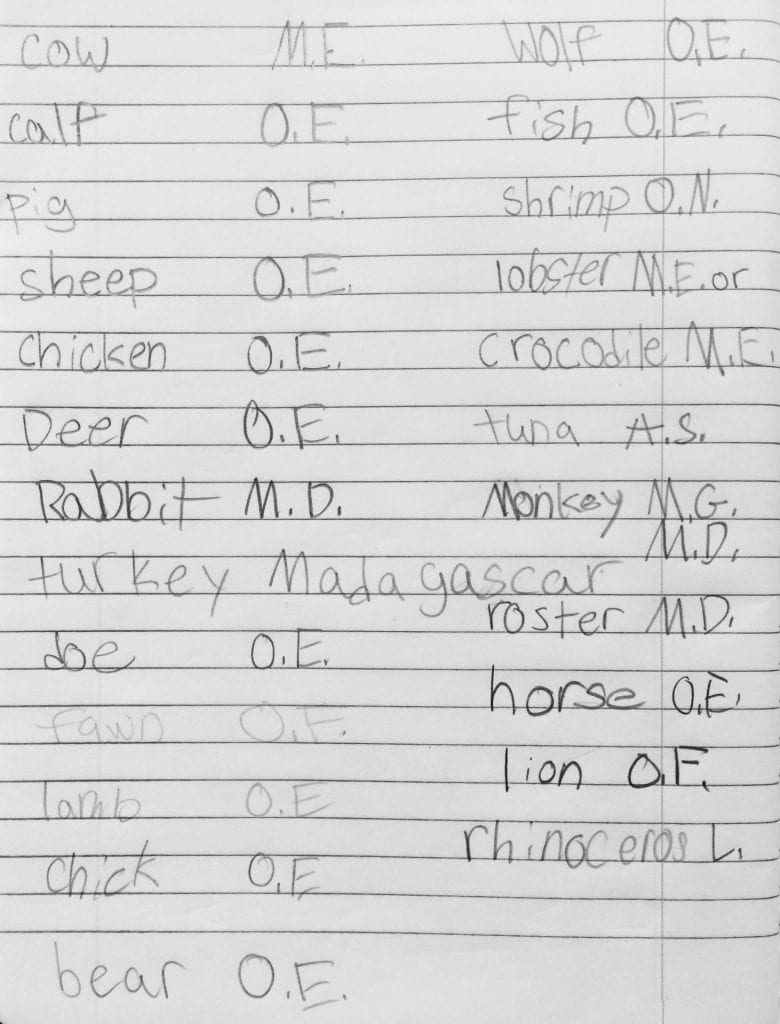


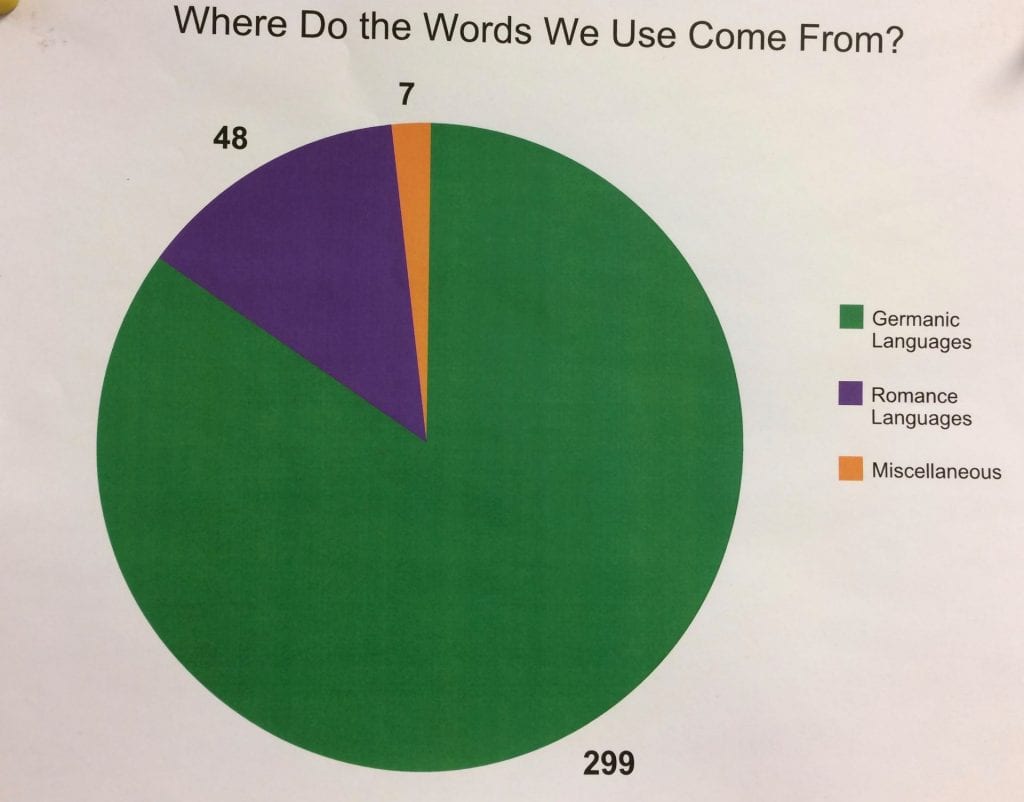
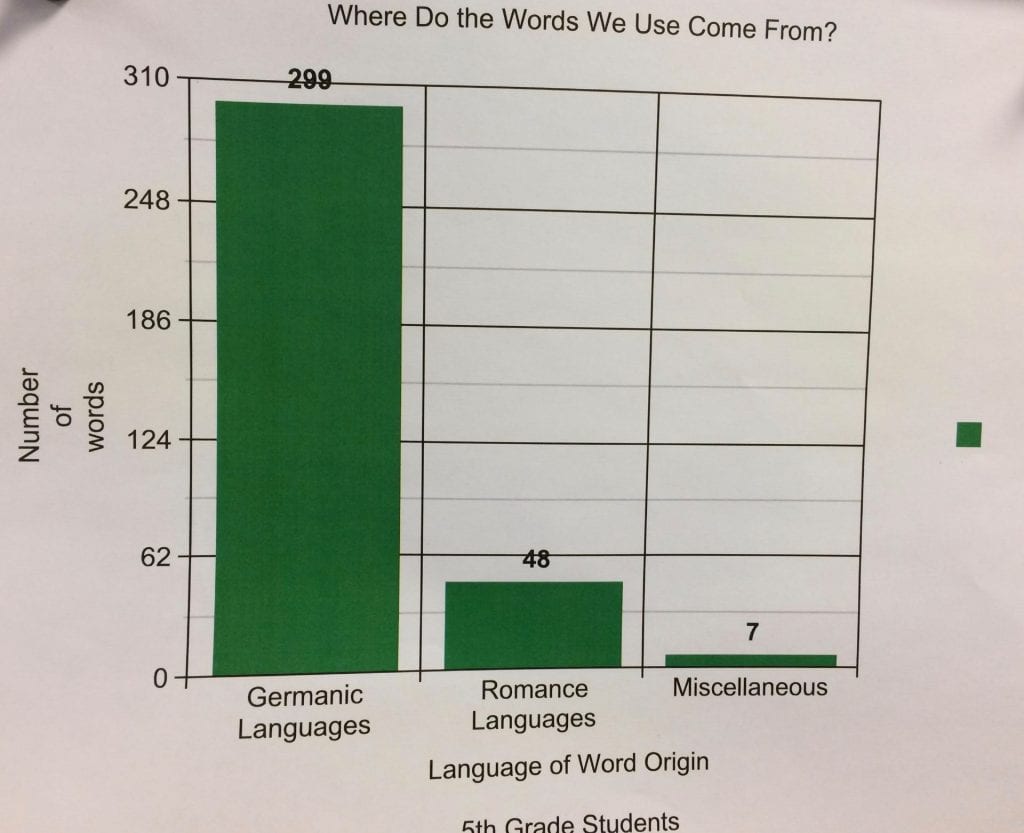



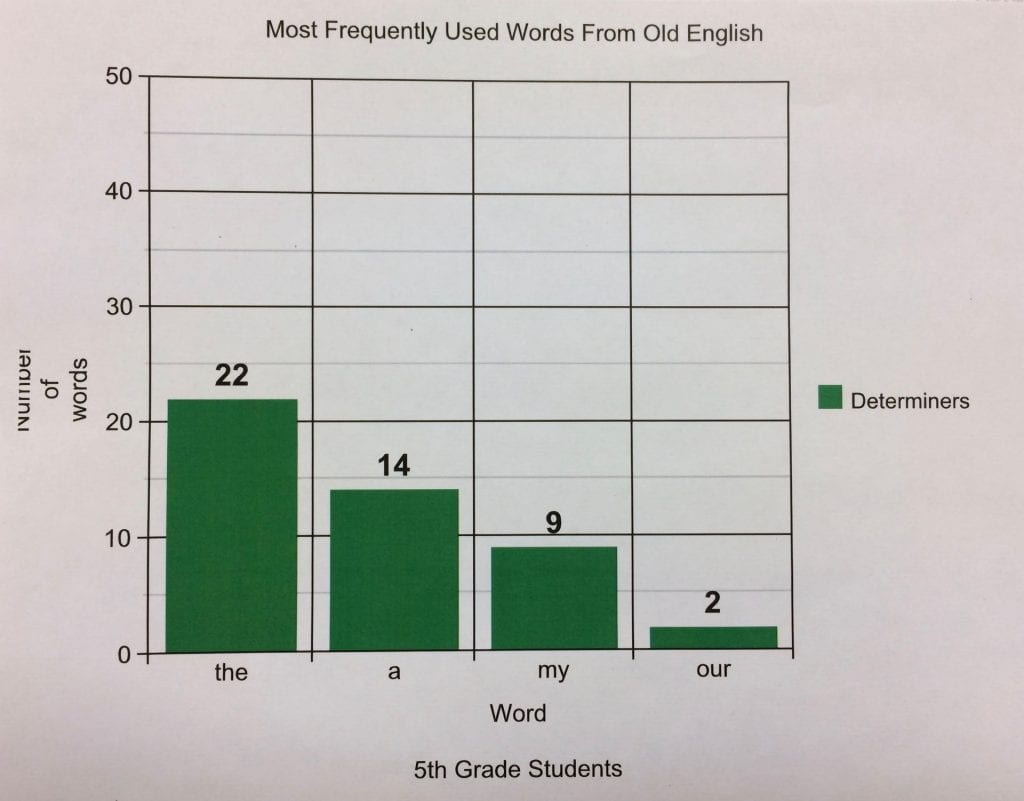

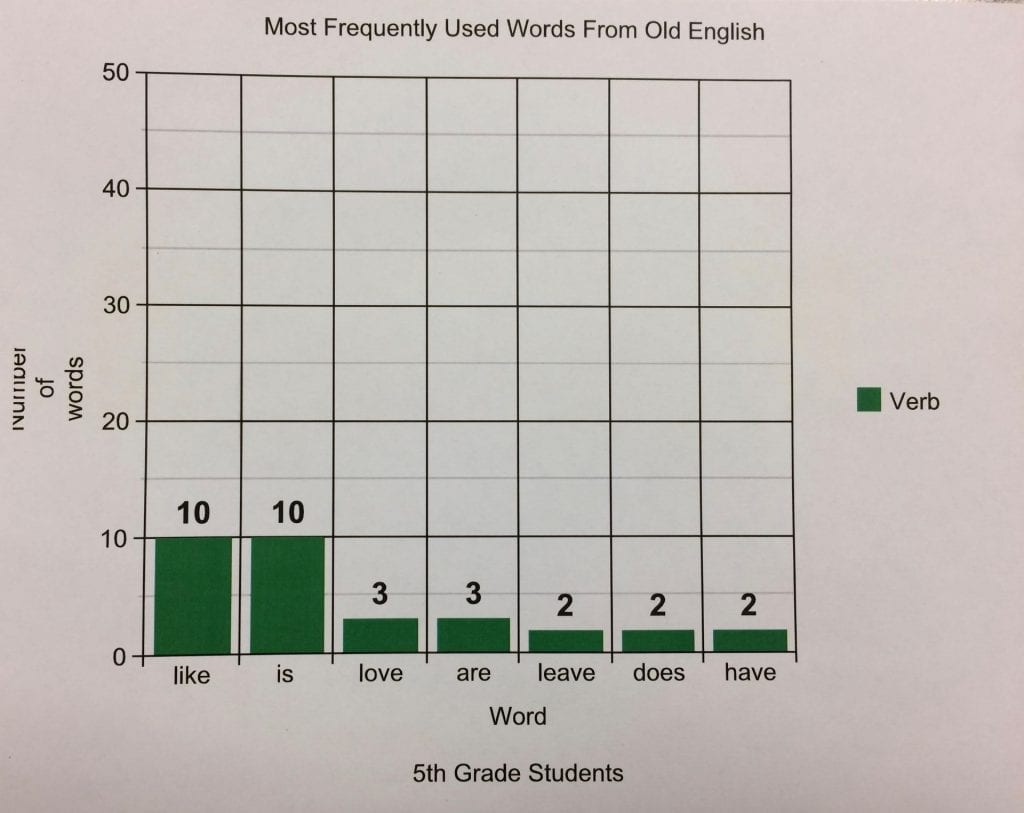

Thank you so much for all the work and for sharing.
It is really interesting!
Thank you for the time you spent detailing this rich investigation! My 4th grade students and I are currently investigating Old English etymology, and I’m going to try the sentence activity tomorrow. I’ll let you know how it transpires! (High register Latinate word there!)
I look forward to hearing what they think about their findings. We are definitely more connected to our language’s history now. Stories of the invasions that happened in England are now as personal to us as any stories of the history of the United States!
My students and I look forward to hearing how it goes.
Mary Beth
This is so interesting and FUN.
Thank you, Carolyn. We found it interesting too. It was a study that convinced us all that Old English is the bedrock of our language. We have our footing now and can appreciate how the other languages affected our modern day language!
Mary Beth; I am so thankful to you for beginning this group and for accepting me in to it. Today, with a 4th grade group, we began your idea of looking at words to decide if it (ing) was a suffix or not. They will continue until I meet again with them next week to get more comfortable with etymonline and word searcher. Then we will look at other suffixes. We already had a fabulous discussion about dying and tying!
Can’t wait to try this idea with them as well. I meet with my groups weekly so it will be a long process but I also loop with them to 5th grade so it’ll be fun to continue!
Hi Lisa,
It’s truly great to hear that fourth graders are getting to know suffixes and the tools they can use to investigate words! If you ever have any questions or are stumped about something that came up with the students, please email. By the way, I think your students will love that you are learning alongside them!
Mary Beth
Thank you for all your detailed information and video links on your discovery process! It is so encouraging and informative! Thank you for sharing !!!
Thank you, Julie. This was engaging for the students. They enjoyed learning that they were strongly connected to the Anglo-Saxons through the language they speak.
I learned so much from this posting, so much rich information, thank you Mary Beth and your students!
Thank you, Noreen. This was fun. It was like finding relatives on a family tree. We were delighted with so much of what we discovered!